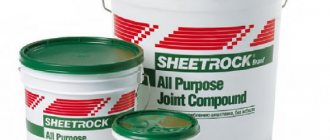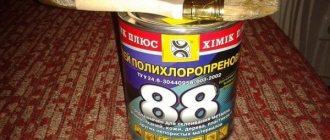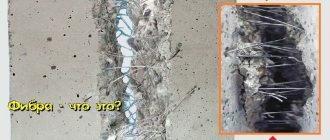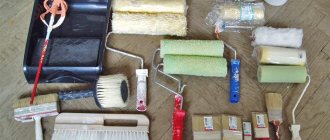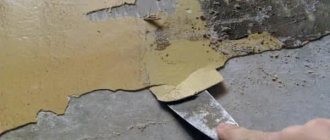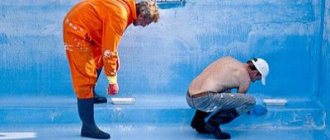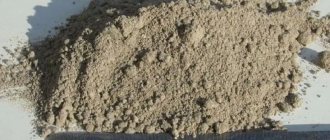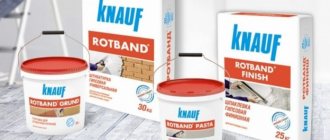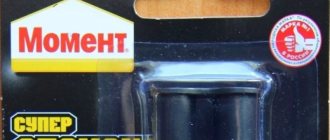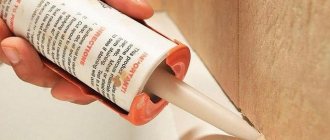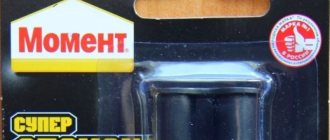From Sheetrock to Danogips
The Danogips brand belongs to the Danogips company. In Germany, everyone knows this brand of construction and finishing products, but on the domestic market this name is a new product. The manufacturer produces dry and ready-made mixtures, primers, and gypsum boards. The quality of the goods is very good, and the prices are quite economical.
Ready-made Sheetrock putties also belong to the Danogips brand; they have gone through a design change with updated packaging. In the CIS countries, up to 1/3 of the entire market of ready-made wall putties is occupied by Shitrok. Now on sale there is a line of three products bearing the name of the umbrella brand Danogips, but retaining the composition and properties of Sheetrock.
What is Shitrok APJC finishing putty?
Almost all types of finishing putties are made on a polymer base with the addition of fine fillers, gypsum, resins and stabilizers, which makes most types of thin-layer finishing materials somewhat similar to each other in characteristics and capabilities. But even in such conditions, the use of Shitrok putty makes it possible to bypass its closest competitors, for example, Vetonit and Multifinish, in terms of the quality of the resulting surface.
The main difference from competitors is that Shitrok, like putty, is a highly specialized material that is good only under specific conditions of use:
- The thickness of the laid layer does not exceed 0.1-0.5 mm, although the manufacturer allows a maximum thickness of the working layer of up to 2 mm;
- After applying the putty, the surface is not sanded or sanded;
- Finishing putty is not used to level the walls; the surface is covered with the thinnest possible layer, filling the risks, microcavities and pinhole defects remaining from the preliminary finishing.
Important! It is not recommended to prime Shitrok putty laid on gypsum bases; this degrades the quality of the finish and, as experts say, can erode the finishing coat of the surface.
The finishing compound Shitrok is used in 99 cases out of 100 for final finishing before painting walls. After drying, the finishing putty gives the effect of frosted glass - an even and uniform layer, translucent in thickness. Once painted, it is almost impossible to tell how many layers have been laid on the drywall or concrete surface. You can apply two or three layers with polishing, but the total thickness of the finishing putty should not exceed 2 mm.
The secret of the composition of the branded finishing material Shitrok
Most craftsmen who professionally prepare walls using putties recognize the high plasticity of the Shitrok finishing mass, excellent adhesion and relatively low shrinkage of the material. Specialists from the manufacturing company provide the following approximate composition of Shitrok APJC:
- Finely ground limestone or dolomite of fraction 20-40 microns, most often these are magnesium-calcium carbonates of natural origin;
- Ethylene-vinyl or acetate-vinyl copolymers;
- Atapulgite and pyrophyllite, which provide a dry sliding effect, when the finishing putty, even with too much pressure from the spatula on the surface, easily slides over a dry base.
For your information! Shitrok APJC putty is positioned as a completely ready-to-use product - open the package and you can finish the walls.
But this does not explain all the nuances of high ductility and strength. In fact, the composition of the putty should be much more complex and voluminous than what American technologists say. At a minimum, the Shitrok finishing mass must include mixture separation stabilizers, preservatives and thickeners.
As an additive that can make the finishing putty more airy and viscous, like whipped butter cream, cellulose microfiber is used, which is quite expensive and difficult to produce. The fiber provides excellent ductility and strength of the Shitrok layer even on a glass surface. To prevent microcellulose from causing the development of mold or mildew, liquid preservatives based on polyhydric alcohols are always included in the formulation for the production of Shitrok putty.
The enormous popularity of Shitrok putty and its high cost have become the reason for numerous counterfeits, but artisans, as a rule, limit themselves to replacing microcellulose with ordinary carboxymethylcellulose, so such finishing masses are stored much worse.
Features of the material
Putties are suitable for all occasions, therefore they are considered universal. Their main purpose is to level walls made of concrete, plasterboard, brick before finishing, painting, or wallpapering. The description of the material states that it has high ductility. Indeed, the polymer finishing putty Shitrok has a number of advantageous features. They are due to their unique composition, which includes:
- finely ground limestone;
- fine fraction dolomite;
- ethylene-vinyl or acetate-vinyl copolymer;
- pyrophyllite and attapulgite.
The last mentioned materials give a dry sliding effect. This makes it easy to putty the walls on a dry surface. Of course, the composition also contains other components - substances that prevent the mixture from separating, preservatives, thickeners, stabilizers. Also, a special cellulose microfiber is used to add airiness to the mass. Due to its presence, the product becomes like whipped cream. The same component ensures high strength of the layer after puttying. Polyhydric alcohol is added to the composition, which prevents fungus and mold from multiplying.
The features of the material are:
- attaches well to the wall;
- does not fall off the spatula;
- perfectly smooth after drying;
- beautiful white or cream color;
- the mass dries quickly;
- The material is moisture resistant, but quite breathable.
In addition to puttying plasterboard or other surfaces, the material is also suitable for other purposes. Shitrok is suitable for removing cracks and defects on walls made of concrete, brick, and plaster. You can use putty to seal any seam between sheets of drywall on walls, ceilings and partitions, and apply connecting tape on top. Using Shitrok, corners are processed and metal surfaces are finished. With Shitrok you can create a beautiful decorative surface with a certain relief.
Preparing Shitrok putty for work
- Stir lightly. Stirring too vigorously can introduce air bubbles into the mixture, which will negatively affect the quality of the putty.
- If it is necessary to add water, then no more than 0.25 liters, then mix, apply for testing.
It should be remembered that excess water increases shrinkage (cracks may form), as well as deteriorates adhesion to the base.
- Mixing with other material is prohibited.
- After finishing work with putty, do not forget to tightly close the lid of the bucket.
Necessary tools and materials for puttying
- Spatulas 12, 20 and 25 cm wide.
- Sheetrock Joint Tape (serpyanka or self-adhesive mesh Strobi)
- Sponge, sandpaper.
Material characteristics
The technical characteristics of the material allow it to maintain leadership in the market of similar products. Here are its main parameters:
- drying time - 3–5 hours;
- methods of working with mass - manual, mechanized;
- temperature of application of the material - from +13 degrees;
- density - 1.65 kg/l;
- packaging volume - sold in buckets of 3.5–17 liters.
The high density of the product can be intimidating, because the more dense it is, the more difficult it is to grind the material. But this does not apply to the Shitrock brand. Sanding the dried putty mass is very simple; a mesh with a grain size of 180 units is used for this purpose.
Specifications
Sheetrock putty is perhaps the best option for finishing rooms. This building material has many advantages that guarantee the quality of the final result. The technical characteristics of putty make it a leading product on the construction market:
- The finishing material dries from 3 to 5 hours;
- the mixture can be applied mechanically or manually;
- ready-made Shitrok putty has a special consistency that is suitable for treating any type of surface;
- the mixture ideally eliminates defects, which makes it suitable even for painting;
- The product can be used at temperatures from 13°C;
- The goods are packaged in containers of various volumes - from 3.5 to 17 liters.
Such characteristics are currently considered advanced, because each of them is thought out to the smallest detail in order to simplify the technology of using mixtures and their further operation.
Advantages and disadvantages
What is better, Shitrok putty or other mixtures? This product has a huge number of advantages that distinguish it from its analogues:
- There is no need to mix the product; it is sold in finished form. After opening, you can immediately start working, which will save time and effort.
- The material is universal, it is suitable for leveling walls and finishing. You won't have to buy another finishing product.
- The product has a unique texture. The oiliness, smoothness, and plasticity of the putty allows it to adhere perfectly to the spatula and the wall. This makes the job much easier for a beginner. Ease of use is due to the ease of rubbing and puttying the layer.
- The fairly low consumption per 1 m2 of putty makes it attractive for those who value calculation and are trying to save money without sacrificing quality. The savings are also due to the thin layer thickness; there is no need for a thick coating.
- The material is sold in containers of different sizes; you can choose the one you need for each individual case.
- After drying, the surface will be very beautiful, smooth, pleasant to the touch, and primer can be easily applied to it. The material does not shrink; the manufacturer guarantees a minimum of 5 years without even small cracks.
- Shitrok will completely replace the primer. To do this, you just need to dilute it with water to a liquid consistency, then use it as a standard primer. Shitrok is also compatible with any brands of other construction and finishing materials.
- The shelf life of the package after opening is several months. If you close the lid tightly and place the material away from heat sources, storage for a year is allowed. By the way, it can be frozen; for further use, you need to defrost it at room temperature.
Shitrock doesn't have many downsides. After application to the wall, the shade of the material becomes not white, but light beige. This may negatively affect the color of the walls, which are planned to be painted white. Also, the disadvantages include the need for thorough preparation of the surface - it must be cleaned, degreased, and leveled in the presence of rough irregularities and defects. If this is not done, the adhesion of Sheetrock to the base will decrease.
Variety of Shitrok line
On the finishing materials market, Shitrok finishing has 3 variations, each of which is intended for specific purposes:
- Taping Joint Compound. Its role in finishing is to restore the surface, eliminate cracks, and seal seams. The material has excellent adhesion to plasterboard boards. The resulting thin layer of putty is endowed with excellent strength indicators.
- Topping Joint Compound. It has minimal shrinkage and is mainly used for repeated application to the treated surface. Shitrok finishing putty is not used to fill joints.
- All Purpose Compound. A universal option, suitable for any job. The composition is especially good at creating textures on the surface, forming original designs and patterns. The material is recommended for work in rooms with high humidity, but it is also irreplaceable under other conditions.
The choice of material depends on the goal that the master has set.
Product range
There are three products available in the Ready-Mixed category. Among them, users can find one that is useful in a given situation, depending on the purpose of use.
Danogips SuperFinish
Putty of the Superfinish category is a finishing material for the final finishing of the wall. Super finish is a ready-made polymer mass with high adhesion quality, which is suitable for the following surfaces:
- fiberglass;
- drywall;
- painted walls.
The product is not suitable for sealing large cracks and seams. Superfinish gives a perfectly smooth surface.
Danogips Fill&Finish Light
Fill Light putty is also used as a finishing coat. It is suitable for laminating the base and smoothing out small defects. The composition contains latex, which gives the material special strength, scratch resistance, and moisture resistance.
Danogips ProSpray
Danogypsum Pro spray is a multifunctional (universal) product that is suitable for every surface and any type of finish. They can be used to make decorative surfaces, be used to seal seams and cracks, and level the joints of brickwork.
Types of Shitrok putties, how to choose
Sheetrock putty is available in more than one form; there are three options for puttingtying the surface inside a building. They differ in their properties. Below is a description of each.
Danogips SuperFinish
This is Sheetrock finishing putty, applied when finishing the surface. Superfinish is a ready-to-apply product that can be used on materials such as fiberglass, paint layers, and plasterboards.
After coating, a smooth, leveled surface is obtained, but it will not be possible to repair large irregularities with it.
Superfinish is a ready-to-apply product that can be used on materials such as fiberglass, paint layers, and plasterboards.
Sheetrock Fill Finish Light
Suitable for smoothing small defects, can be used as a laminating coating. The composition uses latex, so it has waterproof properties and is resistant to the formation of flaws on the surface.
Suitable for smoothing small defects, can be used as a laminating coating.
Sheetrock All Purpose
This option is universal. Can be used for various purposes. It is also used as a material for filling gaps in brickwork. Actively used for surface texturing.
The choice is made based on the task at hand: the first type is suitable for finishing, the second for finishing drywall, the third can be used for mechanized application.
Can be used for various purposes.
Application technique
How to work with the material? There are no particular difficulties or differences from working with other putties. It is only important to prepare the surface for processing, while the humidity in the room should be minimal. To prepare, do the following:
- clean the walls of old coating;
- level differences of more than 2 cm;
- perform priming.
After complete drying, you can start working with Shitrok. Take a little material from the bucket, place it in a convenient container, and place it on the floor or on a stand. Take the putty with a spatula and apply it to the wall in one thin layer. Layer thickness is 1–2 millimeters. After covering the entire wall, you need to take a break for drying - 3-5 hours. Then you can do sanding. The consumption for fiberglass is higher, since 3 layers need to be applied, in other cases 2 layers are enough.
There are some peculiarities in the use of putty in different versions. When finishing seams, work is done as follows:
- take a 12 cm spatula and use it to fill the seams with the prepared mixture;
- Place the tape in the center and press it in;
- remove the mass that has come out at the edges, apply a little of it on top of the tape;
- seal the fastener heads with material (if necessary);
- After 3 hours, apply a second coat and sand as it dries.
When finishing internal corners, putty is applied to 2 sides of the tape with a 12-centimeter spatula. Then the tape is folded in the center, pressed to the corner with a spatula, and the excess mass is removed. After drying, repeat the steps 2 more times. At the end of the work, wipe the surface with a damp sponge.
Material consumption
Before starting work, it is important to use a calculator to calculate the required amount of material. Standard consumption is liter per 1 square meter. More is spent on the joints of plasterboard sheets - 28 kg are spent per 55 m of linear seams, or 0.51 kg/m linear. Texturing consumes 28 kg per 20 square meters. m, or 1.4 kg/sq. m.
Do I need to level the surface before application?
Danogypsum Shitrok putty solution must be applied only to a completely dry base, where any remaining dust after sanding has been removed. Also, when creating a two-layer coating, you need to dry each layer.
The temperature in the room must exceed +13 degrees for optimal drying. Sanding work using sandpaper is carried out with material with a grain size of 240 or less.
Danogypsum Shitrok putty solution must be applied only to a completely dry base, where any remaining dust after sanding has been removed.
Sheetrock, Knauf “Rotband paste” or Vetonit LR - which is better
The materials listed are the most popular among finishers. But there are features that must be taken into account when choosing. Thus, Shitrok creates the smoothest surface even without sanding. After sanding, it must be primed, but without sanding this step can be skipped. Shitrok is ideal for painting, the most durable.
Primer must be applied on top of Vetonit; this material is best suited for subsequent wallpapering. The disadvantage of Vetonit in comparison with Shitrok is less plasticity, but the color is perfectly white. Another disadvantage of Vetonit is the need for dilution, while Shitrok is a ready-made mass.
When comparing Shitrock and “Rotband paste” from Knauf, the following should be noted. There are few differences in the recipe; Knauf also makes high-quality material with small marble particles and a polymer matrix. The surface after finishing coating from Knauf remains perfectly smooth; it does not need to be polished or sanded. Typically, “Rotband paste” is purchased if a thicker layer is planned to seal wall defects. Shitrok involves thin application - up to 2 millimeters. You should select the material based on your needs - then the quality of the work will not cause any complaints.
Practical use of Shitrok finishing materials
The putty is sold in packages of 17 liters, less often 3.5 liters. The lid on the bucket is secured with a standard Euro-lock using a plastic ring pressed into the annular segment of the container. It is enough to tear off one of the segments by hand to remove the cover from the mount. This does not damage the lock, and it can be snapped back into place if you need to store unused material. With a standard consumption of 1 liter per square, one bucket of Shitrok is enough to finish puttying the walls of a 15 m2 room.
The putty mass placed in the container is covered with plastic film, this avoids water loss and protects the surface from delamination and drying out. The color of the original putty is not white, rather grayish, but always uniform in tone, without spots or traces of discoloration. Old finishing material may take on a slightly yellowish tint, especially if the putty was stored in a poorly sealed container or in a warm place. To restore the working condition of the Shitrok putty, just mix the mass thoroughly and let it sit for half an hour.
Technique for applying Sheetrock finishing coatings
The finishing putty is laid on a prepared, plastered and sanded wall, on which there are no seams or joints between the slabs; the surface is maximally leveled by laying serpyanka and preliminary puttying.
If the finishing mass remains open, due to loss of water, the viscosity increases to the consistency of rich sour cream. In this case, the finishing material can be restored:
- The first time, mix thoroughly dry, without adding water;
- The second time it is mixed with the addition of clean water, without any soils or deoxidizers, in small portions of 30-40 grams. The mixed putty is allowed to “rest” for 10-15 minutes;
- The last time is to check with a spatula the ability of the finishing mass to stretch without much effort; if the desired thickness of the Shitrok finishing layer is obtained, you can begin to putty the surface.
The technique for applying the finishing putty mixture Shitrok is practically no different from other materials. A small amount of putty is applied to a wide spatula, and the material is stretched on the wall surface with a wide, uniform movement. In order for the Shitrok finish to be uniform and durable, it is necessary to achieve the thinnest, translucent layer of putty. The first and second layers take three to four hours to dry. The final drying of the wall puttied with Shitrok before painting with water-based emulsion occurs within 24 hours.
Layer thickness and finishing options
Numerous enthusiastic reviews about the quality and capabilities of Shitrock often confuse ordinary users. They begin to seal the seams with finishing putty, fill in the holes and use Shitrok as a regular gypsum-polymer mass, laying it a few millimeters thick. Firstly, this is an insane waste of money, and secondly, the finishing mass is slightly different in characteristics from the pre-putty materials.
Of course, Shitrok is harder and tougher than Vetonit, and can be sanded better, but the risk of cracks increases tenfold. With the correct organization of the process, the first layer, thicker and softer, can be applied from Furgen, or, in extreme cases, Ventonit LR, and only after that the finishing layer of Shitrok is applied. If it is necessary to lay a thick layer of Shitrok, use pre-glued fiberglass.
The only case when it can be considered advisable to lay a three-millimeter layer of finishing putty is when the plaster is artificially aged with antique microcracks, in the crackle style. But even in this case, it is necessary to control the quality of the surface by laying branded paper for reinforcing thin plasters.
Competitor and classmate Shitrock
In addition to Sheetrock APJC putty, you can successfully use the German version - SuperFinish from Knauf Bauprodukte. In fact, there are few differences in the recipe, for example, the Germans use the finest marble dust, 25 microns in size, as a filler, and the product of co-polymerization of ethylene with pure vinyl acetate as a polymer matrix.
Marble and oil copolymer provide a higher quality surface that does not require sanding and polishing as is the case with APJC coating. The adhesion of both materials is very high; as a rule, there are no problems with applying paint or peeling off the coating.
Advantages
- No difficulties to use. After opening the bucket, you can immediately start working. No kneading required. Minimum amount of waste. Holds perfectly on the spatula. Leveling is amazingly easy. Minor differences in layers.
- Simple sanding process. The result is surfaces of excellent quality. Provided that the sanding was done by professionals and two layers of paint were applied on top, then everything will look perfect.
- Long shelf life. Even if the bucket is left open all day, the remaining Shitrok will not harden.
- Convenience and durability of buckets. However, a seventeen-litre Sheetrock bucket weighs twenty-eight kilograms and is quite difficult for some people to carry.
